Carpenter ants and termites have many similarities, one of which is that they are both known for inflicting wood damage in properties. Although carpenter ants and termites have a lot in common, there are certain physical characteristics that may help you distinguish them.
So, what’s the difference between carpenter ants and termites? Carpenter ants are reddish or black ants that chew into wood to construct their nests while termites are creamy white or transparent insects that consume the cellulose fibers found in wood for their nutrition.
Do you suspect a carpenter ant or termite is eating away at your home’s wood frame? To properly identify which insect is causing damage, read this article for more information!
Are Carpenter Ants Termites?
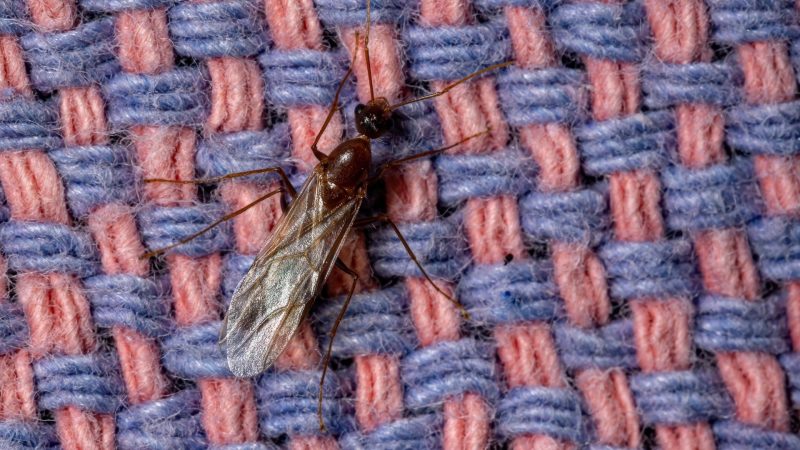
Carpenter ants don’t consume wood. Instead, they primarily chew into the wood when they build tunnels for their nests. Therefore, they are not the same as termites, which consume the cellulose fibers found in wood.
Do Carpenter Ants and Termites Live Together?
Carpenter ants and termites are natural enemies so they cannot live together. Carpenter ants feed on termites but they also benefit from termites since they eliminate any competitors for ideal nesting spots.
Are Carpenter Ants a Sign of Termites?
Carpenter ants are not a reliable indicator that your property is infested with termites. The carpenter ants may live on your property without the presence of termites since the latter are not their primary food source.
What Is the Difference Between Carpenter Ants and Termites?
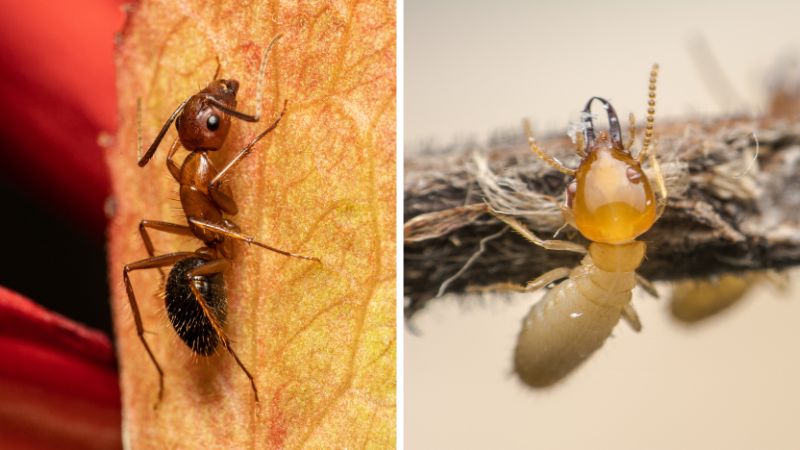
It’s important to tell carpenter ants and termites apart so that, in case of infestations, you know the proper way of dealing with them. The following are the differences between these two insects:
- Color. Carpenter ants are reddish or black, while termites are transparent or creamy white.
- Body shape. Carpenter ants have narrow waists, while termites have more broad waists.
- Antennae. Termite antennae look like tiny beads or balls and are straight, unlike carpenter ants which are curved and pointy.
- Wings. Termites have four equal-sized and shaped wings. It also has wings that are bigger than its body. Carpenter ants have two big forewings and two tiny back wings
- Food source. Termites destroy wooden buildings because they need the cellulose in the wood to grow. Carpenter ants, unlike termites, eat other insects like flies, food leftovers, aphids, animal bones, and other insects. Sugars and proteins attract them.
- Wood tunnels. Carpenter ants can construct smooth and polished tunnels. The termite, on the other hand, creates rough holes that are filled with mud and dirt. A mud tube made from wood and soil indicates a termite infestation.
- Visibility. Mud tubes and wood damage are all signs of termite infestation, and they also avoid light. Meanwhile, carpenter ants may wander out to seek food so that you may discover them around your property.
What Are the Distinct Similarities Between Carpenter Ants and Termites?
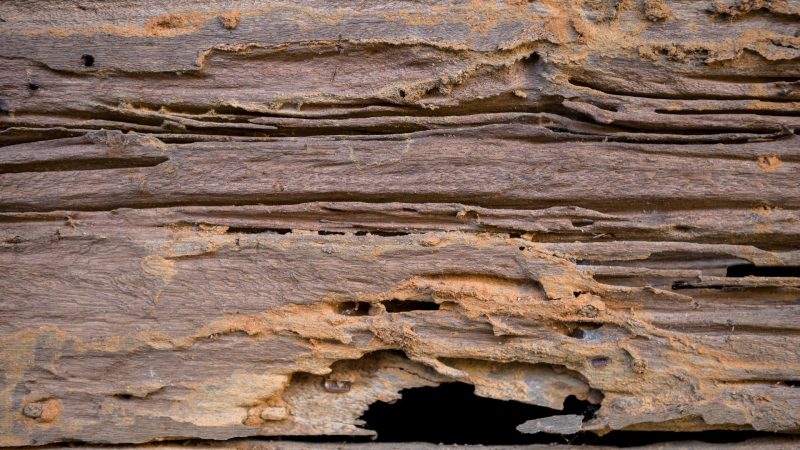
The following are some similarities between carpenter ants and termites.
- Attractions – Ants and termites are attracted to moisture in your property. They’re also attracted to damaged timber and simple access points.
- Nest – Chimneys, broken doors and window frames, sinks, crawl spaces beneath roofs, and bathtubs are common places for both insects to establish their nests.
- Colony – Termites and carpenter ants have both queens who lay eggs and kings who fertilize them. Furthermore, each has a worker caste that accomplishes most of the activity and a military caste that protects the nest.
- Damage – They are both proven to affect wood damage in properties, although carpenter ants do less damage. Additionally, carpenter ant infestations are also less expensive when it comes to control, compared to termite infestations.
Do Carpenter Ants Kill Termites?
Termites have a soft bodies and are blind so they are easy prey. Moreover, they provide a good source of nutrients for carpenter ants. But take note, it’s a terrible mistake to use carpenter ants for the treatment of termites since you’re simply replacing one problem with another.
Are Carpenter Ants Worse Than Termites?
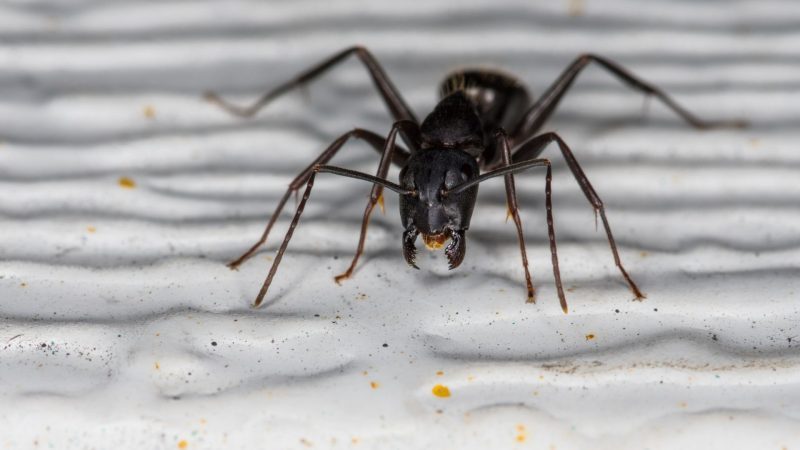
Carpenter ants and termites can both pose a risk to your property, especially if you have a lot of wooden structures. Although both can do major damage to wooden buildings, termites will inflict greater damage and in a smaller duration of time than carpenter ants.
Do Carpenter Ants Eat Wood Like Termites?
No, carpenter ants simply chew into wood so that they have a clear pathway to build their nests. They gain no nutritional value whatsoever from this activity. On the other hand, termites consume the cellulose in wood to provide nutrition to their bodies.
How to Know if You Have Termites or Carpenter Ants?
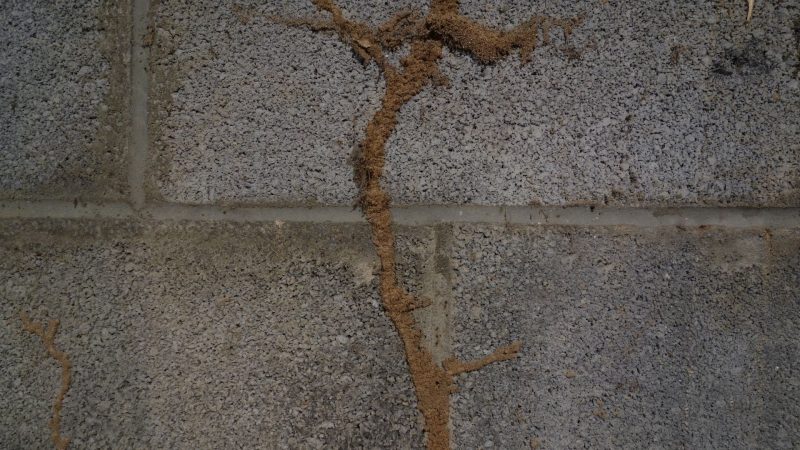
Here are the common signs of termite and carpenter ant infestations, and how you can tell them apart:
| Termite Infestation | Carpenter Ant Infestation |
| Termites create mud tubes from their saliva, dirt, wood, and waste components to maintain moisture and shelter. | Carpenter ants nest directly in decayed or moist wood, creating galleries and tunnels for them to go into. |
| A termite-damaged wood makes a hollow sound when knocked or tapped. | An active carpenter ant colony makes dry, rustling sounds that get even louder when the ants are disturbed. |
| The presence of termite waste, is called frass. It is a combination of chewed wood, feces, and saliva, usually the same color as the wood. | The presence of coarse sawdust. These are chunkier in appearance than frass. |
| Sightings of flying adults during the day, particularly in the summer and fall seasons. | Sightings of worker ants or winged ants, particularly during the late winter and lasting until the spring season. |
How to Treat Carpenter Ants and Termites?
Treatment for both insects vary slightly. This is why it’s important to identify which one you’re dealing with so you can tailor your control methods accordingly. Here’s how you can get rid of them:
Carpenter Ant Treatment
The easiest technique to get rid of carpenter ants is to locate the nest and eliminate the queen. Here are some suggestions for discovering and eradicating carpenter ants:
- Find the nest. Examine the suspicious wood for evidence of damage. Carpenter ants are frequently found nesting around sinks, tubs, and other moist areas. Check also for visible moisture damage around firewood piles, tree stumps, and wood structures outside.
- Destroy the nest. Once you’ve found a nest, drill a hole in the wall and inject pesticide dust into the hole you drilled where the carpenter ants nest is located. You may need to repeat treatments several times to eliminate the nest. Here are some good products to choose from:
- Industrial grade strength
- 99.9+ percent pure
- Anhydrous (without water)
- High quality boric acid
- Powder form
- Natural Product - Composed of 2lbs of 100% ground freshwater...
- OMRI Listed - Listed with the Organic Minerals Research...
- Powder Duster Included - Powder duster in the bag for easy and...
- Supports a Great Cause - Harris donates 10% of profits to support...
- Made in the USA – Mined in Nevada and packaged in Georgia
- Unmatched Control of Bed Bugs: Even strains resistant to...
- Low-Toxicity, Non-Repellent, Odorless, Non-Clumping and...
- The Preferred Treatment for Tough Indoor Spiders
- Labeled for treating cracks, crevices, voids, mattresses,...
- Extremely effective against fleas, ticks, lice, roaches, ants,...
Related: Best Carpenter Ant Baits: Reviews & Guide | Indoor and Outdoor
Termite Treatment
On the other hand, termites may be treated in the following ways:
- Baits for termites. Termite baits consist of cellulose such as wood and a pesticide that disrupts termites’ natural development cycle. The termites die when trying to mature within weeks after swallowing the bait. These baits are either buried or placed in crawl areas close to the soil.
- Treatment of the soil. The ground is contaminated with termiticide. As a result, termites are killed as they crawl through the soil.
- Wood treatments. Infested wood should be treated. Prime and paint it when the termite spray, such as borate which deters termites, has set. To do this, you will need 1 teaspoon of borax powder to 8 ounces of hot water, mix until thoroughly dissolved.
Here is a video about borate wood treatment:
Related: How Much Does Termite Treatment Cost? | A Detailed Guide
Does Termite Treatment Kill Carpenter Ants?
No. Liquid pesticides should never be used to treat carpenter ants and sprays will only kill the carpenter ants that have been exposed. The queens will be unaffected by spraying.
Related: Are White Ants and Termites the Same? | All You Need to Know!
List of Sources
Fisette, P. (2002). Controlling Termites and Carpenter Ants.
Hahn, J. (2020). Carpenter Ants.
Potter, M. (1997). Carpenter Ants.
University of Connecticut. (2022). Termites & Carpenter Ants.
- Bed Bug Surge 2025: How to Detect, Prevent, and Safely Eliminate Infestations in Top U.S. Cities - June 18, 2025
- Asian Needle Ants Invade US Homes: 2025 Guide to Identification, Risks, and Effective Control - June 11, 2025
- New World Screwworm Alert: How US Livestock Owners Can Prevent Outbreaks and Protect Herds [Summer 2025 Update] - June 8, 2025




